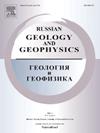作为Tannu Ola岛弧和图瓦-蒙古微大陆(图瓦东部)交界带地壳年龄标志的Kaa Khem岩基花岗岩的岩浆和外来锆石
IF 1
4区 地球科学
Q3 GEOSCIENCES, MULTIDISCIPLINARY
引用次数: 0
摘要
–我们介绍了Kaa Khem岩基东部(图瓦东部)斜长花岗岩组合的地质结构、岩石学组成和年龄的研究结果。岩基位于旺甸-早寒武纪的Tannu Ola岛弧(TIA)与图瓦-蒙古微大陆(TMM)的前寒武纪岩石的交界地带。该地区的斜长花岗岩类在490–450 Ma期间形成于吸积-碰撞环境中。已经建立了斜长花岗岩组合的三个形成阶段(~489、~476和~450 Ma)。Kaa Khem岩基东部的斜长花岗岩组合在岩石学组成和年龄上与西部的斜长岩石组合(500–450 Ma)没有差异。Kaa Khem东部岩基研究的斜长花岗岩中的外来锆石年龄为2335–517 Ma。它们的年龄分为几个簇(524–517、549–536、615–586、684–647、739–735、810–794、842–827和2335 Ma),反映了TIA–TMM交界带地壳的不均匀性。Kaa Khem岩基东部斜长花岗岩中广泛的年龄和丰富的异种锆石证明了在吸积-碰撞过程的所有阶段(490至450 Ma),较老的地壳来源对花岗岩形成的贡献。Kaa Khem西部岩基同时代斜长花岗岩中异种锆石的年龄范围窄得多(616–474 Ma)及其含量低,这与它们在TIA内的定位以及长英质熔体生成区域地壳的相对均匀性一致。在西方,较老地壳源的影响微不足道,仅在吸积-碰撞过程的最后阶段(~450 Ma)才表现出来。本文章由计算机程序翻译,如有差异,请以英文原文为准。
Magmatic and Xenogenic Zircons from Granitoids of the Kaa-Khem Batholith as Age Markers of the Crust in the Junction Zone of the Tannu-Ola Island Arc and the Tuva–Mongolian Microcontinent (Eastern Tuva)
––We present the results of study of the geologic structure, petrologic composition, and age of plagiogranitoid associations in the east of the Kaa-Khem batholith (Eastern Tuva). The batholith is located in the junction zone of the Tannu-Ola island arc (TIA) of Vendian–early Cambrian age and the Precambrian rocks of the Tuva–Mongolian microcontinent (TMM). Plagiogranitoids of this region formed in an accretion–collision setting in the period 490–450 Ma. Three stages of formation of plagiogranitoid associations have been established (~489, ~476, and ~450 Ma). The plagiogranitoid associations in the east of the Kaa-Khem batholith do not differ in petrologic composition and age from the plagiogranitoid associations (500–450 Ma) in the west. Xenogenic zircons in the studied plagiogranitoids of the eastern Kaa-Khem batholith have ages of 2335–517 Ma. Their ages are divided into several clusters (524–517, 549–536, 615–586, 684–647, 739–735, 810–794, 842–827, and 2335 Ma) reflecting the heterogeneity of the crust in the TIA–TMM junction zone. The wide range of ages and the abundance of xenogenic zircons in plagiogranitoids of the eastern Kaa-Khem batholith testify to the contribution of older crustal sources to the granite formation at all stages of accretion–collision processes (from 490 to 450 Ma). The much narrower age range of xenogenic zircon (616–474 Ma) and its low contents in coeval plagiogranitoids of the western Kaa-Khem batholith are consistent with their localization within the TIA and the relative homogeneity of the crust in the area of felsic-melt generation. In the west, the influence of older crustal sources was insignificant and manifested itself only at the final stage (~450 Ma) of accretion–collision processes.
求助全文
通过发布文献求助,成功后即可免费获取论文全文。
去求助
来源期刊

Russian Geology and Geophysics
地学-地球科学综合
CiteScore
2.00
自引率
18.20%
发文量
95
审稿时长
4-8 weeks
期刊介绍:
The journal publishes original reports of theoretical and methodological nature in the fields of geology, geophysics, and geochemistry, which contain data on composition and structure of the Earth''s crust and mantle, describes processes of formation and general regularities of commercial mineral occurrences, investigations on development and application of geological-geophysical methods for their revealing. As to works of regional nature, accelerated publication are available for original papers on a variety of problems of comparative geology taking into account specific character of Siberia, adjacent Asian countries and water areas. The journal will also publish reviews, critical articles, chronicle of the most important scientific events, and advertisements.
 求助内容:
求助内容: 应助结果提醒方式:
应助结果提醒方式:


